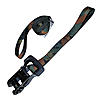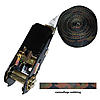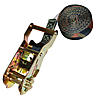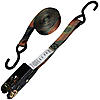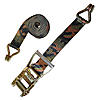
Outdoor Hunting Straps for Treestand and Hunting Applications
When it comes to outdoor hunting adventures one thing is certain and that is a safe hunt is always considered good hunting. When it comes to hunting safety is an absolute must. One of the most dangerous aspects of hunting in the woods is being secured up in a hunting treestand that is 15 to 25 feet in the air for several hours at a time. As most hunting tree stands are installed months in advance it’s extremely important to be able to trust the hunting straps to hold you in place while being outside in the elements for months or years at a time.
Hunting Straps are made from a polyester tie-down webbing blend that provides great amounts of strength, very little stretching, and is designed to be durable in the elements. One of the benefits of using polyester tie-down webbing is there is a wide variety of different webbing colors such as our popular camouflage, black, and colors for almost every hunting application need. No matter if you are securing a tree stand, setting up trail cameras, or setting up an accessory hook.
Let’s begin with ways to improve safety to make your next deer hunting adventure better.

How to Choose The Perfect Tree for a Hunting Tree Stand
•Start by finding a tree with a location where the sun will rise from directly behind you. This helps to prevent the Sun’s glare from potentially stopping you from having the perfect line of sight that you need.
• Look for tracks or indications that deer or other animals are actively moving through the area, this will be the ideal location to consider.
• Areas that are located near food, water, or bedding are often the perfect indicators that the area has high deer traffic.
• Find a tree that is large enough in width to completely cover your body from the other side of the tree. This helps to provide cover in the air as well as knowing that the tree you are secured to your deer stand is able to support the weight.
• Keep an eye out for indicators that may show the tree is unsafe to use such as decay, dead leaves, or many branches falling to the ground as the tree may not provide the levels of safety that you need.
• You will want a tree that provides a height of 15 to 20 feet tall in most circumstances to provide enough height to be out of sight. In some circumstances, you may want a tree to stand higher in the tree such as 25 feet, but it is not a requirement.
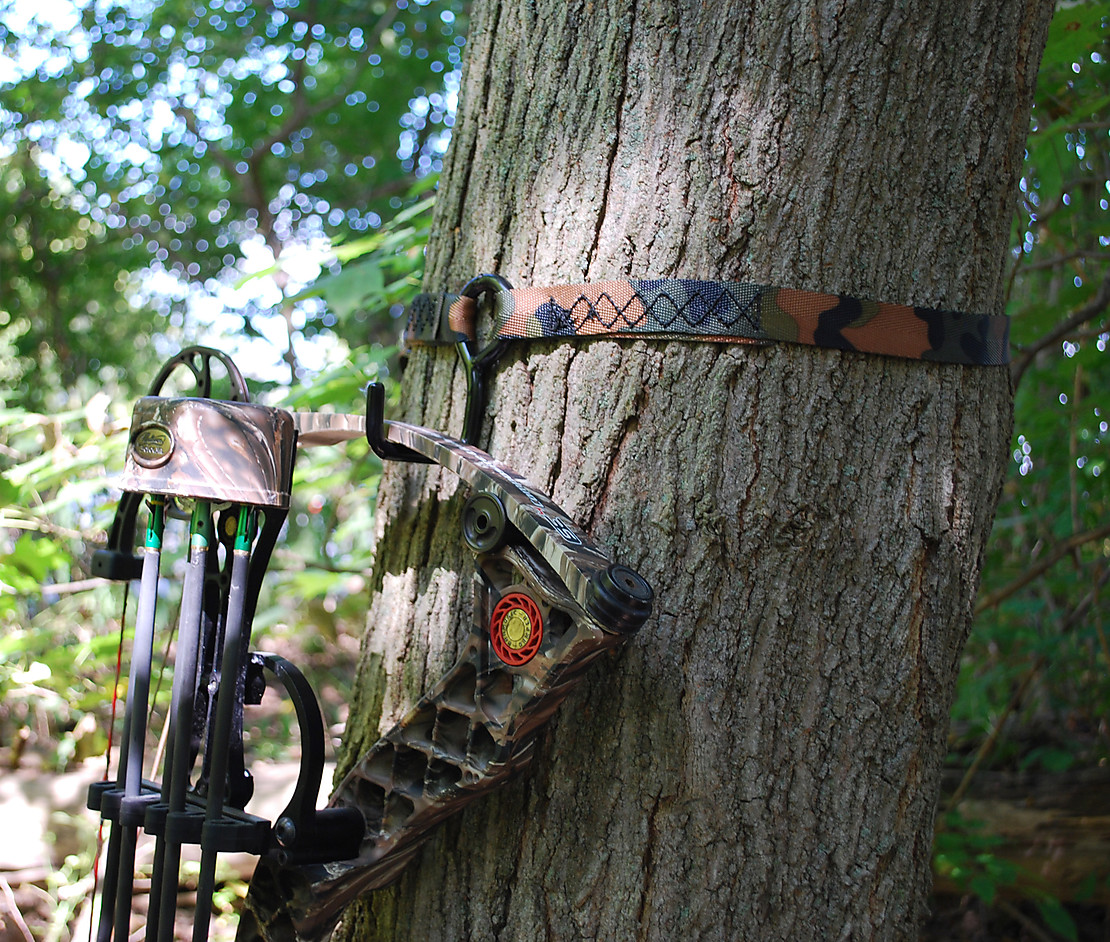
What Type of Hunting Straps are The Best?
Some of the popular camo hunting straps include:
CAMO Ratchet Strap with 5-inch Loops – Our popular CAMO webbing ratchet straps with 5-inch loops are a secure way to ensure that your treestand ladders remain safely secured while out in the woods. One of the biggest downsides to traditional tree stand straps is that they are nowhere as near as safe as they should be in order to keep you safe. Despite only having 1-inch wide tie-down webbing the featuring strength features a 3,000 lbs breaking strength and a safe working load limit of 833 lbs per strap.
1-inch Custom Ratchet Strap with S Hooks – Our 1-inch Custom CAMO Ratchet Strap with S Hooks is one of the most versatile hunting straps on the market and can be used for securing anything from ATVs, Motorcycles, Dirt Bikes, Cargo, and Treestand Ladders. This strap can be made in many different customizations such as the length of webbing and the fixed end length of the strap. This strap features a 500 lbs assembly working load limit and despite its smaller size can be used to secure or hold many different applications in place.
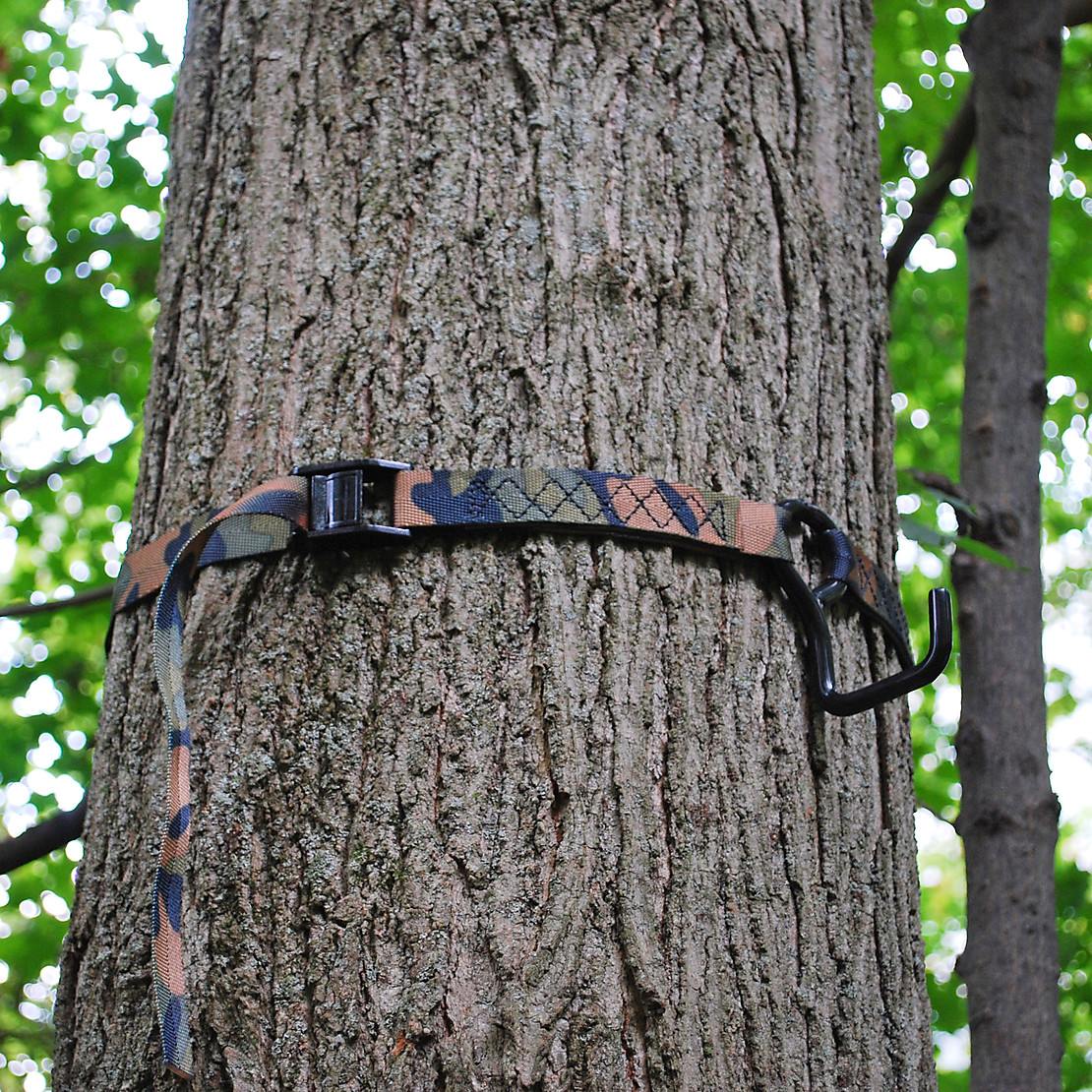
1-inch CAMO Treestand Accessory Hook – Our Treestand Accessory Hook is a great way to hang a bow, backpack, or any other accessory you may need while outside hunting in the woods for long periods of time. This strap is made to be extremely durable and cost-effective with options that fit you best such as custom lengths of webbing to fit almost any tree securement need. This strap is tightened by using our 900 lbs breaking strength cam buckle to provide excellent safety with the ability to quickly tighten into place.
1-inch CAMO Endless Loop Ratchet Strap – Our 1-inch CAMO Endless Loop Ratchet Strap is as the same sound and does not have any hardware at the end of the strap and loops back into itself like a belt. Simply pull the strap to the desired length and then tighten the ratchet in order to have a 500 lbs working load limit, a durable, and cost-effective strap for tree stand ladders in a matter of minutes. The CAMO polyester webbing provides heavy-duty strength, and durability, and stretches very little to ensure the highest levels of safety are met while outside in the woods.
No matter how new or old your tie-down straps are you should always inspect them before and after every use to ensure the highest levels of safety are met. Look for potential damage in the webbing such as fraying, cuts, burn marks, sun discoloration on the webbing, or mold and mildew that could weaken your straps. If you find your straps have any of the defects listed above the straps are unsafe to use and should be replaced. You can view our full guide on how to inspect your ratchet straps for damage in our blog post HERE
Shop our Popular Hunting Tree Stand Straps

When Should You Set Up A Hunting Deer Stand?
The best time for someone considering setting up a hunting deer stand should be at least one month before the planned hunting date. This helps to prevent you from setting up during a hunt and potentially scaring away wildlife from the area and also helps the animals in the area to become aware that they are set up and do not pose a threat.
Setting up treestands are not the quietest tasks to do while in the woods so setting them up well in advance is usually the better. Before using your tree stands you should consider always consider inspecting your straps and re-tighten the treestand as needed.
A lot of hunters will often set up tree stands during the Spring season and leave them up for the remainder of the year. If you are someone who intends to leave the straps and stands up year-round the one thing we recommend is using extra safety at every chance when re-tightening and inspecting, and if at any point you feel unsafe use more straps. There are no rules to how many straps you should use and when it comes to safety it’s better to have more than enough than not enough straps.
We strongly recommend arriving at your hunting location or hunting tree stand before daylight to prevent being seen by potential wildlife you are hunting. By arriving to your hunting stand approximately an hour and a half to two hours early helps to prevent being seen or heard by wildlife.

Frequently Asked Hunting Strap Questions
How often should you replace your hunting straps? – In short, it ultimately depends on how often they are used and how they are cared for. We have several members on our staff that have had their straps outside in their tree stands for over 6 years and are outside year-round without issue. As long as you are inspecting your straps often for damage or defects and they are still considered safe to use they can last quite a long period of time.
Can you place your tree stands higher than 20 feet in the air? – There is really no limit as to how high a tree stand can be in the air. The one thing we always recommend is only going high enough to get the perfect shot and not going as high as possible if it’s not needed. As long as proper safety techniques and procedures are being followed there really is no right or wrong tree stand height placement.
How far can deer smell from? – Deer can often smell from a distance of upwards of a 1/4 of a mile or 1320 feet. This is why it’s extremely important to attempt to mask your smell while out in the woods and not be in the woods too early in some cases.
